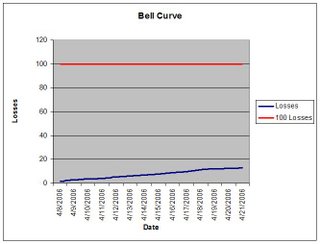This familiar saying about golf encompasses baseball as well. In golf, striking a huge drive will get lots of “Ooos” and “Ahhs” from the crowd, but you won’t get a check until you put the ball in the hole.
With baseball, it’s the offense that most commonly draws the excitement of the crowd. In the “lively player era,” falling home run records had baseball fans scrambling to the ball parks. But did Barry Bonds win a World Series?
It’s pitching and defense that earns wins and dough in baseball.
Unfortunately, we here at Breaking 100 see a disturbing trend. Right now, the Royals have no pitching. They will most certainly lose 100 games this season if they don’t get their pitching figured out.
The sad part is, it seems everybody has known about the Royals’ pitching problems for years except for the Royals. In yesterday’s Yankees game, The Royals were still in the game in the eight, trailing 4-2. Jimmy Gobble entered the game and promptly gave up 5 hits, 5 runs 1 walk and 1 strike out (more on this in a moment). His ERA now stands at a svelte 24.00.
If we take a peek at some recent history, we can see that there have been warning signs about some of these pitchers. In the case of Gobble, he has always had a low strike out rate, which is not a good indication of success in the big leagues. Dan Fox wrote about Gobble in August of 2004. Dan ended his comments with “I would trade him as soon as possible.” Here we are in 2006, and Gobble is providing no value.
Jeremy Affeldt made the starting rotation this year. In the past 3 years, Affeldt has been about as consistent as the weather in Kansas City. Add in the injuries, and the Royals had a pitcher who hasn’t contributed much to this team. But as a lefty with a mid-90’s fastball, he is also a pitcher with some value on the market. They should have traded him a year or more ago.
We can even point to the “sure thing,” Zack Greinke. In the 2005, Baseball Prospectus said of Greinke, “…we have seen the future of pitching, and his name is Zack Greinke.” I respect the writers at BP a great deal, but there has always been a question as to whether Greinke could ever really become a dominant pitcher. Again, Dan Fox, examined Greinke and his “old pitcher skills.” Bill James has never been too keen on Greinke. The reason is that while he is a very intelligent pitcher, he just doesn’t possess the skill to dominate. Without an “out” pitch, Greinke relies instead on changing speeds and deceit. These are the strategies typically employed by older pitchers when they’ve lost velocity. So to pin all of your hopes and dreams on this high school pitcher, who we now know also has some emotional issues, was foolish.
The Royals “lead” the AL in ERA, which now stands at 7.57. Here’s a peek at the 2006 Royals “shock and awe” campaign:
Name | G | IP | ERA |
Wood | 3 | 4.1 | 8.31 |
Stemle | 4 | 3.2 | 9.82 |
Mays | 2 | 7.0 | 12.86 |
Affeldt | 2 | 7.1 | 14.73 |
Sisco | 6 | 4.0 | 15.75 |
Gobble | 4 | 3.0 | 24.00 |
Do any of those performances surprise you? Perhaps Wood, who pitched very will in Spring Training. Well enough to deserve a spot in the rotation. Stemle was terrible in Spring Training. Mays was terrible in 2005 coming off Tommy John surgery. Affeldt and Gobble have well documented problems. Sisco is still young and should probably be at AAA.
Is there hope for the future as we look to break 100? Perhaps Mark Redmond will return from his injured knee and put up some decent performances. It has been said that Greinke may be working toward his return soon. Will he pitch like the Greinke of 2004 (good), or the one of 2005 (not so good).
Only time will tell, but 8 games into the season, the blue line is racing toward the red line too quickly. A reverse of fortune on the mound must occur to avoid the inevitable.
Let's go get 'em.

























